The Discus fish (Symphysodon aequifasciatus), revered as the ‘King of the Aquarium’, is a captivating and species, known for its spectacular colours and distinctive disc-shaped body.
They are native to the Amazon River basin. They’re notorious for being difficult to keep, internet forums are a flood with best practices, water conditions and diet. Some even recommend daily water changes.
Their rarity and the precision required for their upkeep make them a challenging yet rewarding pursuit for dedicated fish keepers. So what are the best practices for taking care of these amazing fish? Well we will cover.
- The ideal tank mates for discus fish
- What to feed them and when
- Keeping them healthy, active with the best tank setup plus much more
Based on our experiences, this article offers the full guide, advice and useful tips for fish keeper of any experience looking to add Discus fish to their aquarium setup.
Table of Contents
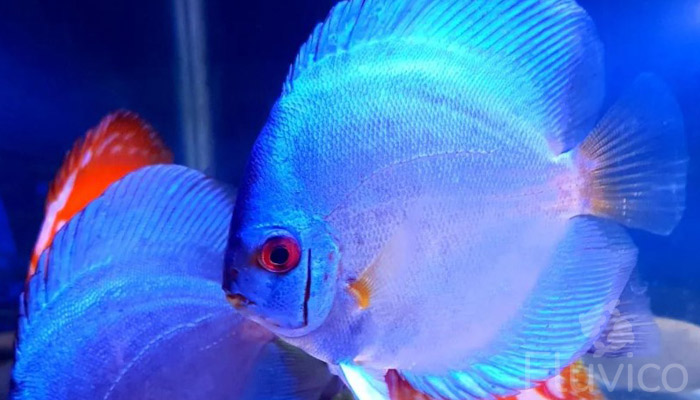
Introduction to Discus Fish
Discus Fish are renowned for their distinctive disc-shaped bodies, spanning up to 20 cm in diameter, coupled with a variety of vibrant colours and patterns.
This contributes to their amazing appearance. This striking visual identity makes them a centrepiece in any aquarium setting.
| Name: | Discus Fish |
| Scientific Name: | Symphysodon |
| Max Size: | Up to 8 inches (20 cm) |
| Lifespan: | Up to 15 years |
| Appearance: | Disc-shaped body with a wide range of vibrant colours |
| Temps: | 27-31°C (85-88°F) |
| Water Parameters: | Soft and slightly acidic; pH: 6.0-7.0 |
| Compatibility: | Peaceful but can be territorial; best with similarly tempered species |
| Community: | Prefers groups, ideally 6 or more for social comfort |
| Lighting: | Moderate, subdued lighting preferred |
| Feeding: | Omnivorous with a preference for high-protein foods |
| Breeding Difficulty: | High, requires specific water conditions and careful pair selection |
Natural Habitat for Discus (Discus fish wild)
Native to the Amazon River basin in South America, Discus fish inhabit warm, soft, and slightly acidic waters of slow-moving tributaries and floodplain lakes.
This environment, rich in dense vegetation and submerged roots, offers them shelter and a diverse food supply. These conditions are vital for their behavioural and physiological development, mirroring the intricate biodiversity of the Amazon.
The balance of the Amazonian waters, rich in organic matter and teeming with a variety of microorganisms, forms the perfect backdrop for the life cycle of these majestic fish, showcasing the remarkable adaptability and resilience of Discus in the wild.

Discus Fish Types
Varieties and Colours
Red Discus Fish
Red Discus fish captivate with their deep, vivid red hues, making them a standout variety. The intensity of their coloration requires meticulous care, especially in maintaining pristine water conditions and a balanced diet. Their striking appearance and the challenge they pose in upkeep render them a prized choice.
Blue Discus Fish
Blue Discus fish are celebrated for their serene blue tones, ranging from sky blue to deep indigo. This variety’s tranquil colour palette adds a calming presence to any aquarium.
Yellow Discus Fish
Yellow Discus fish bring a burst of brightness with their sunny, golden-yellow shades. Their cheerful appearance is a highlight in aquariums, creating a lively and inviting environment. Like their colorful counterparts, maintaining their brilliant hue requires attentive care.
Other Colour Varieties of Discus Fish
- Green Discus Fish: Displaying shades from light green to turquoise, these fish add a unique, natural touch to aquariums. Their colour reflects their health and environment, necessitating careful attention to diet and water conditions.
- Pigeon Blood Discus Fish: Characterized by a distinctive pattern of red spots against a lighter background, they are a popular choice for their striking appearance.
- Albino Discus Fish: These rare and captivating fish lack pigmentation, presenting a pale, almost ethereal appearance. Their care is more demanding due to their sensitivity to light and environmental conditions.
- Spotted and Striped Varieties: Including the Leopard and Snake Skin Discus, these types are known for their intricate patterns. They require stable environments to maintain their detailed markings.
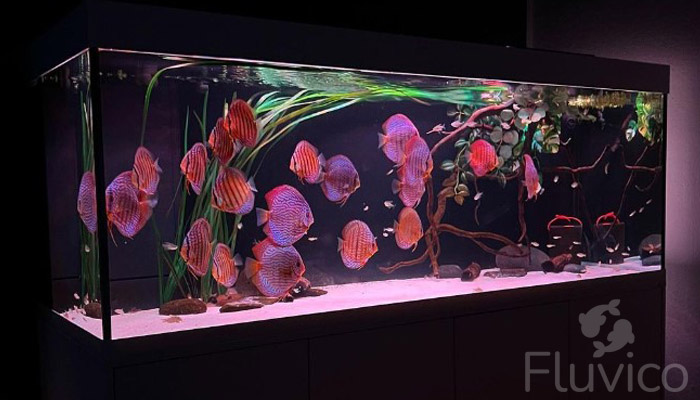
Discus Tank Setup
Housing Requirements for Discus
- What Size Tank Do You Need for Discus: A larger tank is always better. A 75-gallon (280+ litres) tank or larger is recommended, though a 55-gallon (200+ litres) tank is possible but will require frequent water changes. These fish can grow up to 5 to 7 inches in diameter, and a larger tank helps manage waste and reduces aggression among them.
- Can You Keep Discus in a Planted Aquarium: They can be housed in a planted aquarium, but it is important to choose plants that can tolerate high temperatures. Suitable plants include anubias, java fern, bacopa, sword plants, and micro swords. Additionally, adding air stones is recommended to increase oxygen levels in the water, especially at higher temperatures
Water Requirements for Discus
- What Is the Ideal Temperature for Discus Fish: The ideal water temperature is between 85 to 86°F. Keeping the temperature within this range encourages more active behaviour, better metabolism, faster growth, and more vibrant colours. It’s important to note that this temperature range might differ from typical fish-keeping practices.
- Discus Water Quality and Parameters (Including Daily Water Change Needs): The need for daily water changes depends on various factors, including tank size, number of fish, feeding amount, and amount of biological filtration. As a general guideline, the nitrate level should be kept below 40 ppm for planted tanks and below 20 ppm for non-planted tanks. Water changes are essential to remove waste build-up and maintain water quality. An aquarium water test kit can help with this.
- Discus Tank Décor: The general recommendation for Discus tanks is to create an environment that mimics their natural habitat. This includes providing ample hiding spaces and a comfortable setting that supports their wellbeing. General logs and drift wood can provide for this.
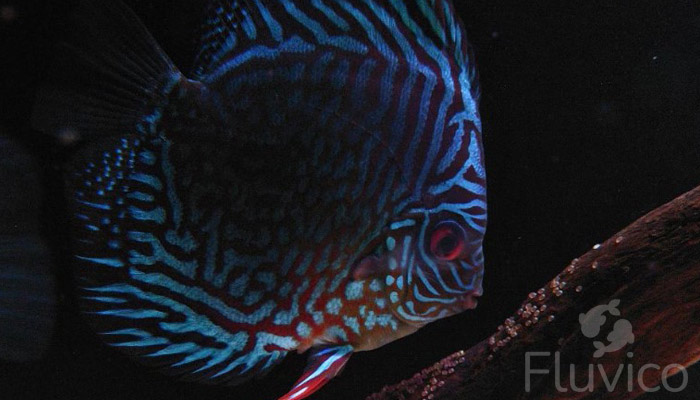
Feeding and Nutrition
What Is the Best Food for Discus Fish?
- Proper Food Size: They have small mouths, necessitating small-sized food to avoid eating difficulties.
- Dietary Variety: Include Hikari Vibra Bites, Sera Discus Granules, Tetra Discus Granules, Hikari Discus Bio-Gold, and other nutrient-rich options.
- Additional Food Choices: Incorporate frozen or live brine shrimp, blackworms, and micro worms for nutritional diversity.
How to Keep Discus Fish Happy and Healthy Through Diet
- Limited Bloodworms: Use bloodworms sparingly; they offer low nutritional value.
- Multiple Feedings Daily: Feed them up to six times a day in small quantities, aligning with their natural feeding habits.
- High-Protein Diet: Frequent feedings of high-protein foods are essential to maintain their weight and metabolism
Community and Compatibility
Discus Behaviour and Compatibility
Discus are peaceful yet intelligent fish, preferring group living for a sense of security. They can exhibit semi-aggressive tendencies during breeding. While not ideal for mixed-species tanks, they can coexist with certain tropical freshwater fish.
Being quite slow feeders, it’s advised to have a Discus only tank to start with as not to get outcompeted for food by speedy fish such as the Tetra. These can be gradually introduced later. Avoid pairing them with cold water or aggressive species due to behavioural and temperature differences.

Tankmates for Discus (Community Tank Considerations)
- Cardinal Tetras: Peaceful and share similar water requirements with Discus, making them suitable for a community tank.
- Sterbai Cory Catfish: Warm water tolerant, do not grow larger than Discus, and help in maintaining the tank’s cleanliness.
- Bristlenose Pleco: Compatible due to their algae-eating habits, small size, and ability to thrive in similar water conditions.
- Ram Dwarf Cichlids: Can coexist peacefully with Discus, provided the tank is spacious enough and water parameters are suitable for both species.
- Angel Fish: They come from the same waters but watch they don’t outcompete the Dicus for food.
Other catfish are suitable, provided they are not larger than the Discus. Large, night-active catfish can spook them. However, it’s important to limit the number of tank mates to ensure the Discus don’t miss out on essential nutrients.
Breeding and Reproduction
How to Sex Discus
Sexing Discus fish involves observing physical and behavioural traits. It isn’t always easy and even professionals can get it wrong.
Males generally have a more muscular body, broader heads, thicker lips, and longer dorsal fins than females, who exhibit rounder bodies and shorter dorsal fins. But this isn’t always an indication as females can develop long dorsal fins too. The genital papilla also differs; males have a pointed one, while females have a rounded one, located just behind the anus.
Behaviourally, males will usually be more aggressive in groups, they will display fins and colours to attract mates. Males often establish and defend territories, a trait less pronounced in females
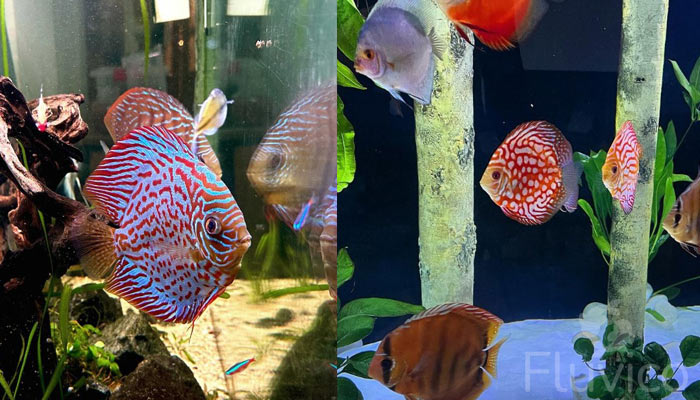
Discus Breeding
Discus fish breeding in an aquarium is achievable but challenging, often requiring months to a year of dedication, especially if starting with juveniles. Previously, successful captive breeding was rare and limited to highly dedicated individuals.
However, hobbyists have recently achieved more widespread success by adhering to specific key steps in the breeding process.
Total time – Several Months
1: Setup
Use a spacious tank with a depth of at least 15 inches. Maintain a temperature above 82°F and pH close to 6.5 with soft water conditions.
2: Feeding
Provide a protein-rich diet, including beef heart, worms, and vegetable matter.
3: Spawning Environment
Include a clean surface like an upturned clay pot or cone for egg laying.
4: Egg Care
Discus will lay eggs on the chosen surface, which they will fan for aeration and remove unfertilized ones.
When and if the discus spawn in this stage, they will lay eggs every week for up to fifteen weeks
5: Hatching and Fry Care
Eggs hatch in 48 hours. Fry initially feed off their mother’s secretion before transitioning to commercial food.
6: Post-Hatching Care
Fry may stay with parents for a while, but it’s advisable to separate them for safety.
In captivity the young can become very aggressive and begin to remove scales from their mother.
Carefully cared for discus fry can yield survival rates of up to 70%
Ongoing Care and Maintenance
How to Keep Discus Fish Healthy and Thriving
To keep Discus fish healthy and thriving, it’s essential to:
- Maintain Optimal Water Temperature: Keep the water temperature between 85 to 86°F. This temperature range stimulates active behaviour, proper metabolism, faster growth, and enhances their coloration.
- Manage Water Quality: Ensure the pH levels are between 6.8 and 7.6 and the water hardness is soft to medium. Regular water changes are vital, with the frequency and amount depending on tank size, number of fish, feeding habits, and the level of biological filtration. Aim to keep nitrate levels below 40 ppm for planted tanks and below 20 ppm for non-planted tanks.
- Minimize Stress: Create a stress-free environment for the Discus. Avoid loud noises and bright lights near the tank, and prevent disturbances like tapping on the glass. A tranquil environment is key to their wellbeing
With these guidelines, you’ll have a happy and thriving Discus tank for years to come making you the envy of your fish keeping friends.
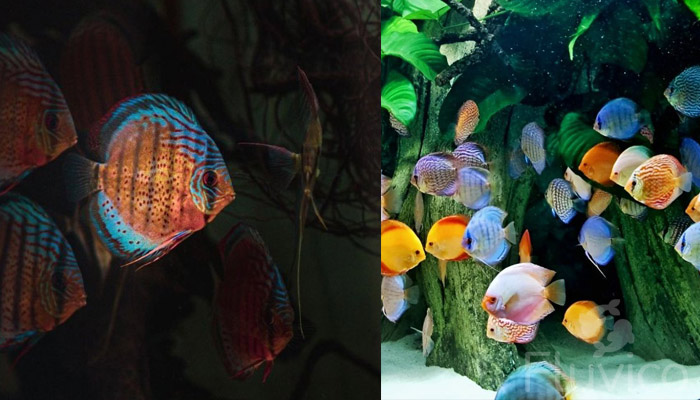
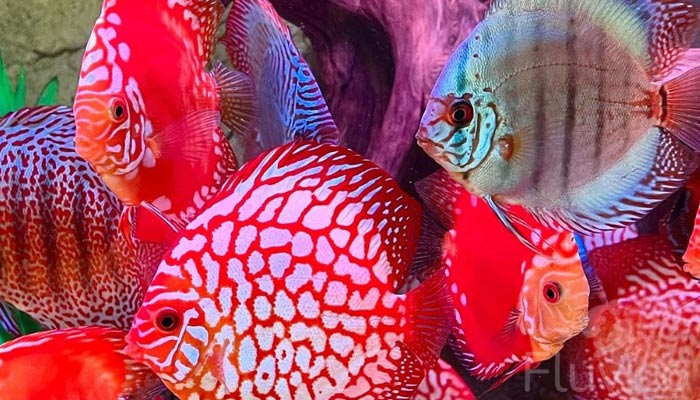
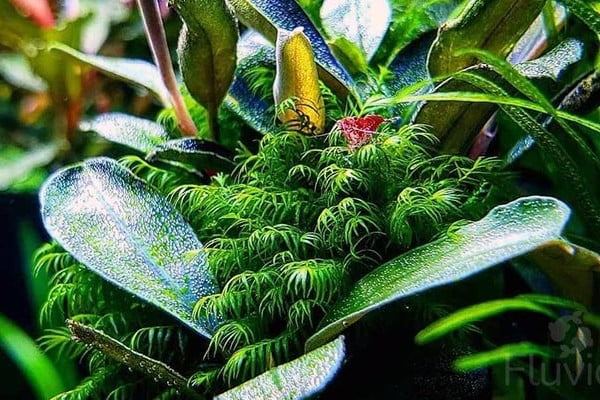
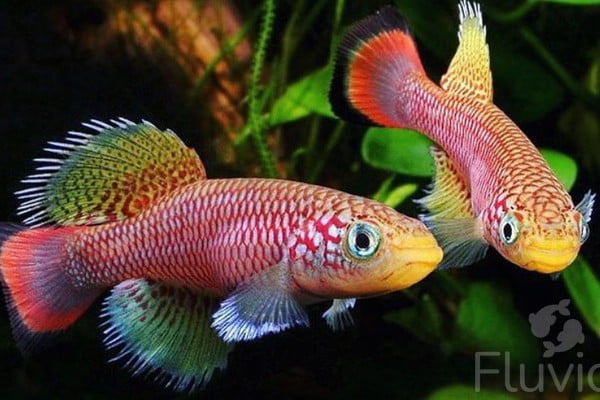
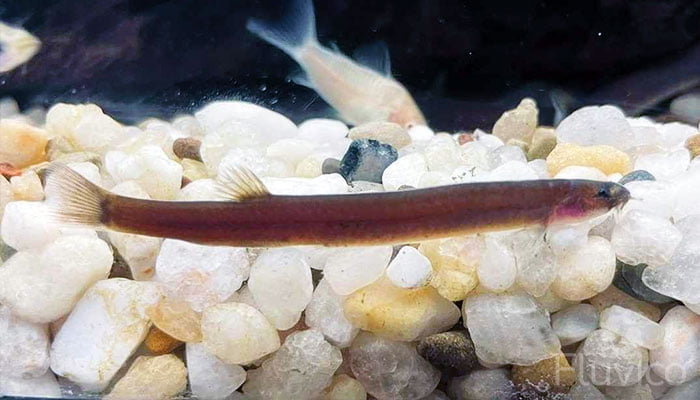

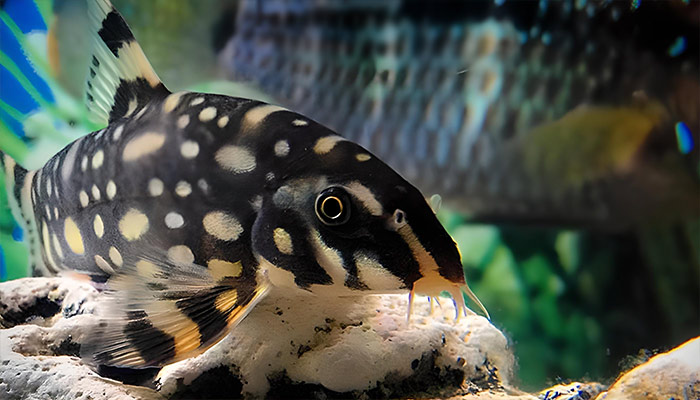
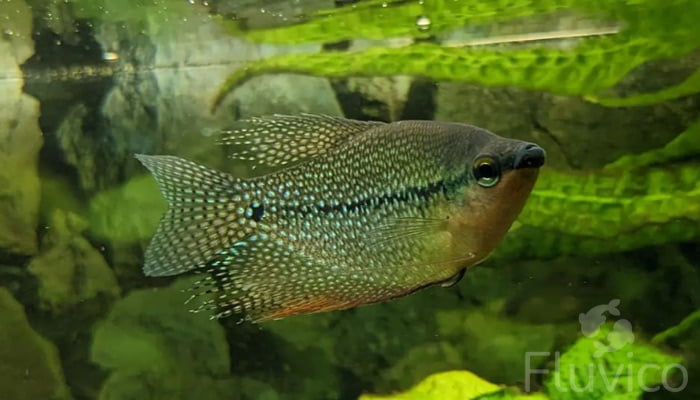
Hope you enjoyed our Discus Fishh Care Guide!
If you have any questions? Ask away, we’re here to help!
All the best,
Daniel